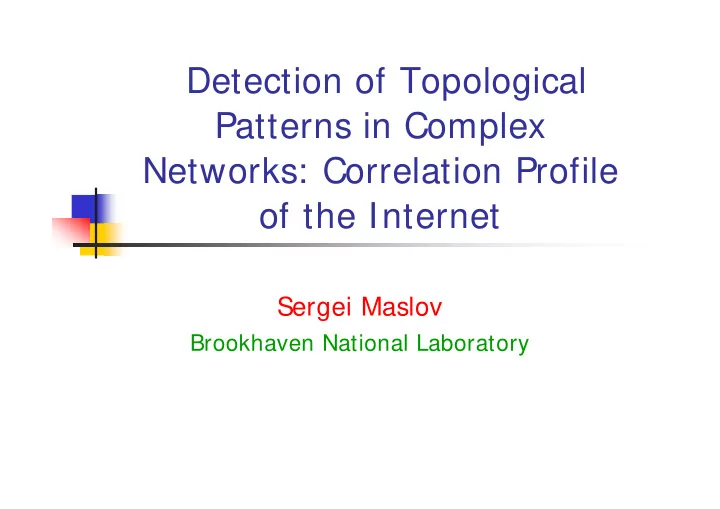

Detection of Topological Patterns in Complex Networks: Correlation Profile of the Internet Sergei Maslov Brookhaven National Laboratory
Outline � Two intuitive algorithms to construct a randomized network with a given degree distribution � S. Maslov, K. Sneppen, Science (2002) � S. Maslov, K. Sneppen: cond-mat/0205379 at arxiv.org (2002), Physica A (2004) � Apply them to detect the 3D plot of degree-degree correlations in the Internet � Is Internet really disassortative?
Which topological patterns are important? � Which topological patterns of a large complex network are there for a reason: � design principles, functional constraints � generated by growth dynamics � Compare the number of patterns in real and properly randomized (null model) networks
What to include in the null model? � Measurable quantities that you deem important! � Degrees of individual nodes � Global connectivity � Clustering, geography, user-provider status, etc. � To discover novel high-level patterns the null model should include all low-level patterns that are “understood” (or commonly accepted)
How to construct a proper random network?
The basic edge swapping (rewiring) algorithm S. Maslov, K. Sneppen, � Randomly select and Science (2002) rewire two edges R. Kannan, P. Tetali, � Repeat many times S. Vempala, Random Structures and Algorithms (1999).
No multiple edges � When constructing a random network – do not allow multiple edges � Expected number of edges between a pair of nodes is E ij = K i K j /(2E) � E h1h2 between the two largest hubs in the Internet circa January 2000 is 1458 * 750/ (2 * 12,573)= 43.5 edges! � Dangerous for γ < 3 as [# of hub-to-hub edges] ~ N (3- γ )/( γ -1)
Rewiring algorithm with a twist “energy” E+ Δ E “energy” E S. Maslov, K. Sneppen: cond-mat preprint at Define energy function arxiv.org � E= (N actual -N desired ) 2 /N desired (2002) N actual - the actual number of e.g. triangles � Published with N desired – what we want it to be � A. Zaliznyak Randomly select two edges and calculate change � Δ E in the energy function Physica A (2004) Rewire with probability p= exp(- Δ E/T) �
Beyond degree distributions: How is it all wired together?
Central vs peripheral network architecture Largest hub is Hubs are peripheral Random in the center (very anti-hierarchical) (very hierarchical) “disassortative” “assortative”
Correlation profile � Count N(k 0 ,k 1 ) – the number of links between nodes with connectivities k 0 and k 1 � Compare it to N r (k 0 ,k 1 ) – the same property in a randomized network � Randomized network conserves degrees of individual AS and the single-component nature of the Internet
Degree-degree correlations in the AS-network [N(k 0 ,k 1 )-N r (k 0 ,k 1 )] / Δ N r (k 0 ,k 1 ) N(k 0 ,k 1 )/ N r (k 0 ,k 1 )
Does it hold for recent data? BGP, March 1-June 1 2005 DIMES, March 1-June 1 2005
4 10 DIMES March- 1June 1 2005 BGP 2 10 log-binned histogram 0 10 -2 10 -4 10 0 1 2 3 4 10 10 10 10 10 degree
Is Internet disassortative?
3 10 2 10 <K neighbor > 1 10 0 10 0 1 2 3 4 10 10 10 10 10 K First reported in R. Pastor-Satorras, A. Vázquez, and A. Vespignani, Phys. Rev. Lett. (2001)
3 10 Randomized Internet 2 10 <K neighbor > Real Internet 1 10 0 10 0 1 2 3 4 10 10 10 10 10 K S. Maslov, K. Sneppen, cond-mat/0205379, (2002)
What to include in a proper random network?
2 nd generation of null models � N(k,k’) may be conserved in addition to N(k) � The null model could be generated by our rewiring algorithm with energy function � Bin the connectivity k into few bins per decade � For a crude model one could use our hierarchical/anti-hierarchical rewiring model � A. Trusina, S. Maslov, P. Minnhagen, and K. Sneppen, Phys. Rev. Lett. 92, 17870 (2004), cond-mat/0308339.
C B C B D A D A 1-p p C B D A
Conclusions � Internet is NOT disassortative! � Network rewiring with a twist – a useful tool to generate random networks with desired low-level topological properties � Could be used to discover non-random topological features e.g. degree-degree correlations (and much more) � Super-hubs do not avoid other super-hubs in the AS-Internet (an artifact of multiple edges in a null model) � Mid-sized nodes like to connect to “user” nodes (degrees 1-3) � User nodes avoid other user nodes
THE END
Recommend
More recommend